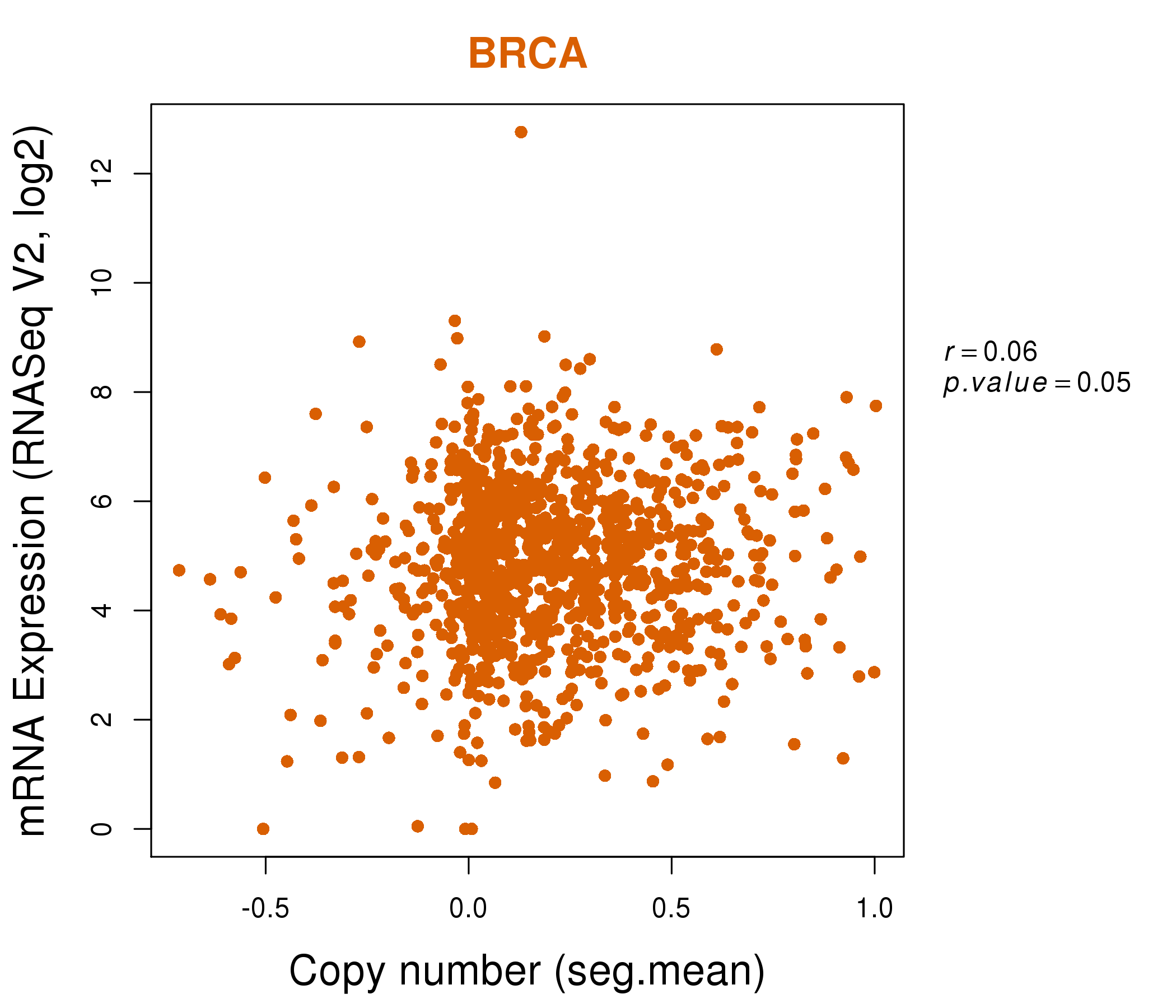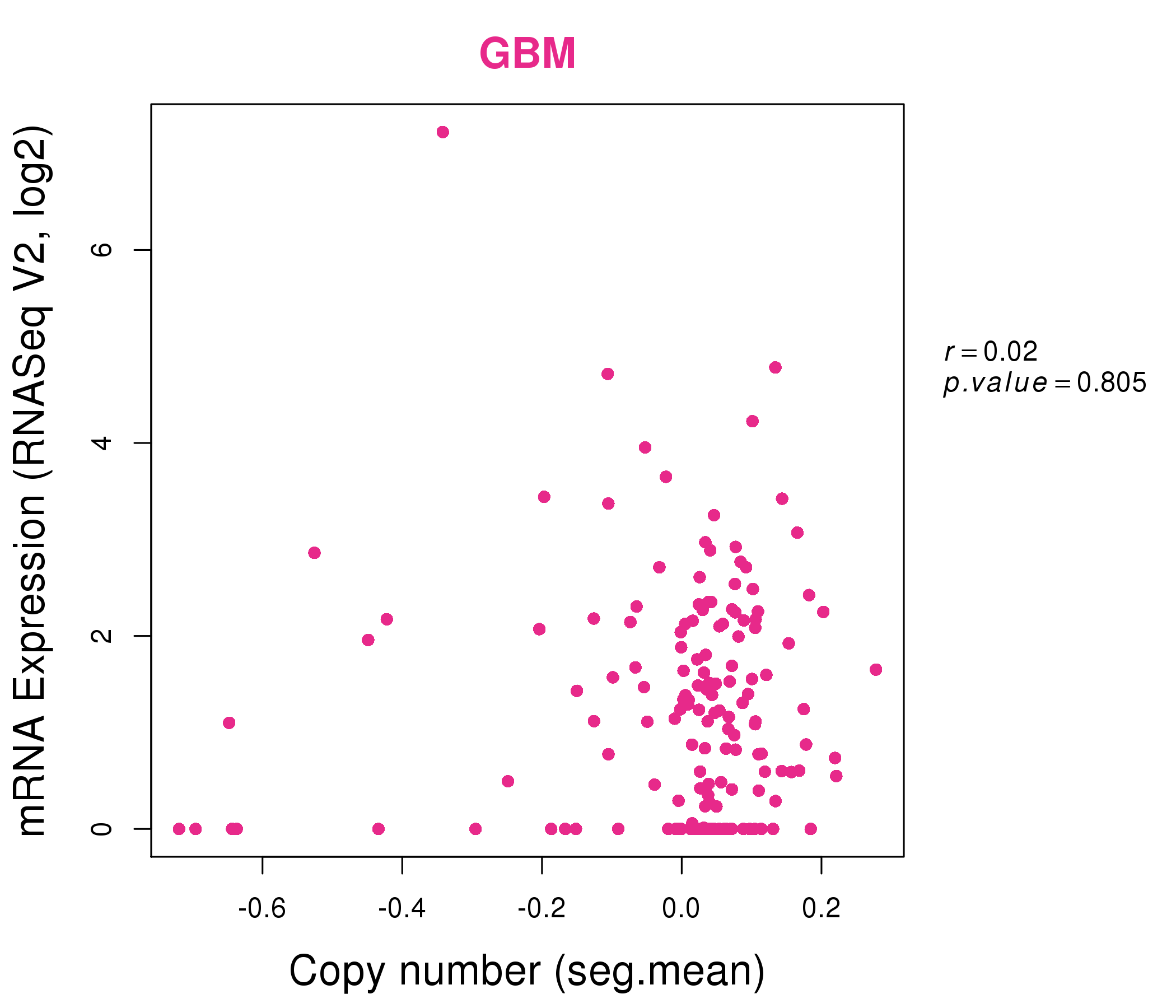|
||||||||||||||||||||
| |
| Phenotypic Information (metabolism pathway, cancer, disease, phenome) |
| |
| |
| Gene-Gene Network Information: Co-Expression Network, Interacting Genes & KEGG |
| |
|
| Gene Summary for ACSM3 |
| Basic gene info. | Gene symbol | ACSM3 |
| Gene name | acyl-CoA synthetase medium-chain family member 3 | |
| Synonyms | SA|SAH | |
| Cytomap | UCSC genome browser: 16p13.11 | |
| Genomic location | chr16 :20775311-20797638 | |
| Type of gene | protein-coding | |
| RefGenes | NM_005622.3, NM_202000.2, | |
| Ensembl id | ENSG00000005187 | |
| Description | SA (rat hypertension-associated) homologSA hypertension-associated homologacyl-coenzyme A synthetase ACSM3, mitochondrialbutyrate--CoA ligase 3butyryl-coenzyme A synthetase 3middle-chain acyl-CoA synthetase 3protein SA homolog | |
| Modification date | 20141207 | |
| dbXrefs | MIM : 145505 | |
| HGNC : HGNC | ||
| Ensembl : ENSG00000005187 | ||
| HPRD : 07033 | ||
| Vega : OTTHUMG00000131552 | ||
| Protein | UniProt: go to UniProt's Cross Reference DB Table | |
| Expression | CleanEX: HS_ACSM3 | |
| BioGPS: 6296 | ||
| Gene Expression Atlas: ENSG00000005187 | ||
| The Human Protein Atlas: ENSG00000005187 | ||
| Pathway | NCI Pathway Interaction Database: ACSM3 | |
| KEGG: ACSM3 | ||
| REACTOME: ACSM3 | ||
| ConsensusPathDB | ||
| Pathway Commons: ACSM3 | ||
| Metabolism | MetaCyc: ACSM3 | |
| HUMANCyc: ACSM3 | ||
| Regulation | Ensembl's Regulation: ENSG00000005187 | |
| miRBase: chr16 :20,775,311-20,797,638 | ||
| TargetScan: NM_005622 | ||
| cisRED: ENSG00000005187 | ||
| Context | iHOP: ACSM3 | |
| cancer metabolism search in PubMed: ACSM3 | ||
| UCL Cancer Institute: ACSM3 | ||
| Assigned class in ccmGDB | C | |
| Top |
| Phenotypic Information for ACSM3(metabolism pathway, cancer, disease, phenome) |
| Cancer | CGAP: ACSM3 |
| Familial Cancer Database: ACSM3 | |
| * This gene is included in those cancer gene databases. |
|
|
|
|
|
| . | ||||||||||||||
Oncogene 1 | Significant driver gene in | |||||||||||||||||||
| cf) number; DB name 1 Oncogene; http://nar.oxfordjournals.org/content/35/suppl_1/D721.long, 2 Tumor Suppressor gene; https://bioinfo.uth.edu/TSGene/, 3 Cancer Gene Census; http://www.nature.com/nrc/journal/v4/n3/abs/nrc1299.html, 4 CancerGenes; http://nar.oxfordjournals.org/content/35/suppl_1/D721.long, 5 Network of Cancer Gene; http://ncg.kcl.ac.uk/index.php, 1Therapeutic Vulnerabilities in Cancer; http://cbio.mskcc.org/cancergenomics/statius/ |
| KEGG_BUTANOATE_METABOLISM | |
| OMIM | |
| Orphanet | |
| Disease | KEGG Disease: ACSM3 |
| MedGen: ACSM3 (Human Medical Genetics with Condition) | |
| ClinVar: ACSM3 | |
| Phenotype | MGI: ACSM3 (International Mouse Phenotyping Consortium) |
| PhenomicDB: ACSM3 | |
| Mutations for ACSM3 |
| * Under tables are showing count per each tissue to give us broad intuition about tissue specific mutation patterns.You can go to the detailed page for each mutation database's web site. |
| There's no structural variation information in COSMIC data for this gene. |
| * From mRNA Sanger sequences, Chitars2.0 arranged chimeric transcripts. This table shows ACSM3 related fusion information. |
| ID | Head Gene | Tail Gene | Accession | Gene_a | qStart_a | qEnd_a | Chromosome_a | tStart_a | tEnd_a | Gene_a | qStart_a | qEnd_a | Chromosome_a | tStart_a | tEnd_a |
| BQ316181 | MLH3 | 27 | 416 | 14 | 75483703 | 75485719 | ACSM3 | 411 | 641 | 16 | 20792103 | 20792449 | |
| Top |
| There's no copy number variation information in COSMIC data for this gene. |
| Top |
|
 |
| Top |
| Stat. for Non-Synonymous SNVs (# total SNVs=66) | (# total SNVs=13) |
 | 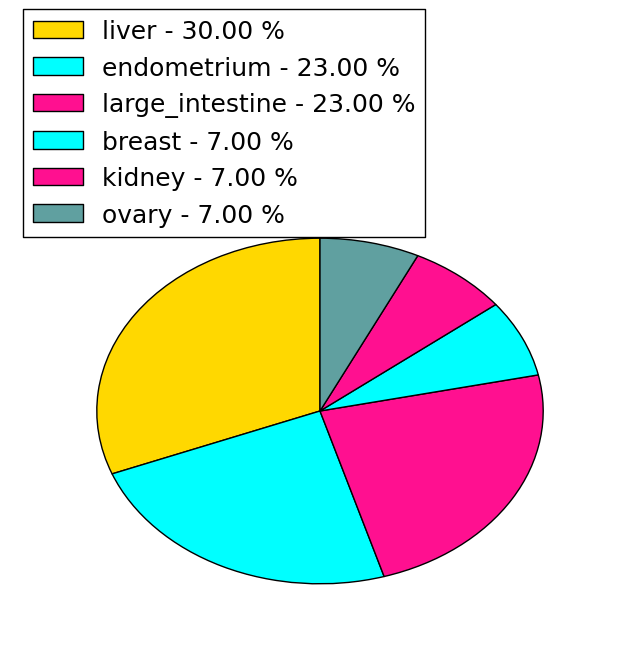 |
(# total SNVs=1) | (# total SNVs=1) |
 | 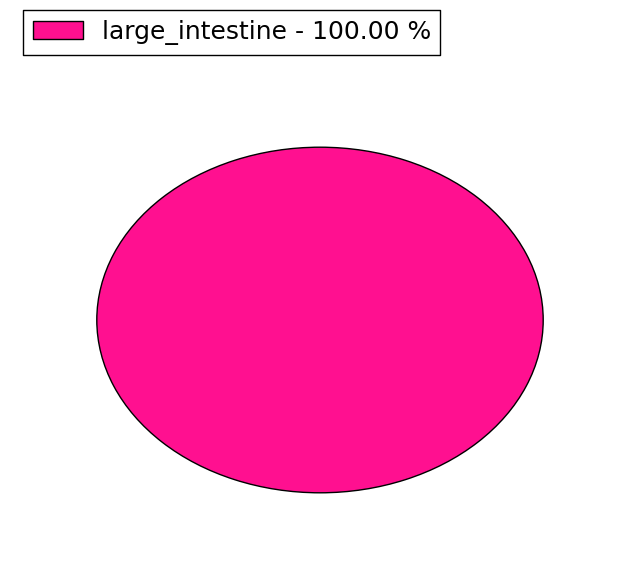 |
| Top |
| * When you move the cursor on each content, you can see more deailed mutation information on the Tooltip. Those are primary_site,primary_histology,mutation(aa),pubmedID. |
| GRCh37 position | Mutation(aa) | Unique sampleID count |
| chr16:20803451-20803451 | p.G485V | 13 |
| chr16:20781479-20781479 | p.S41S | 3 |
| chr16:20793081-20793081 | p.R331* | 3 |
| chr16:20796428-20796428 | p.T381M | 3 |
| chr16:20803563-20803563 | p.R487Q | 3 |
| chr16:20797441-20797441 | p.P395P | 2 |
| chr16:20781555-20781555 | p.Q67* | 2 |
| chr16:20781559-20781559 | p.W68* | 2 |
| chr16:20796405-20796405 | p.Y373Y | 2 |
| chr16:20792168-20792168 | p.S257S | 2 |
| Top |
|
 |
| Point Mutation/ Tissue ID | 1 | 2 | 3 | 4 | 5 | 6 | 7 | 8 | 9 | 10 | 11 | 12 | 13 | 14 | 15 | 16 | 17 | 18 | 19 | 20 |
| # sample | 1 | 1 | 8 | 1 | 4 | 2 | 1 | 4 | 4 | 2 | 7 | 4 | 13 | |||||||
| # mutation | 1 | 1 | 7 | 1 | 4 | 2 | 1 | 5 | 4 | 2 | 7 | 4 | 17 | |||||||
| nonsynonymous SNV | 1 | 5 | 1 | 1 | 2 | 4 | 4 | 1 | 7 | 3 | 15 | |||||||||
| synonymous SNV | 1 | 2 | 3 | 1 | 1 | 1 | 1 | 2 |
| cf) Tissue ID; Tissue type (1; BLCA[Bladder Urothelial Carcinoma], 2; BRCA[Breast invasive carcinoma], 3; CESC[Cervical squamous cell carcinoma and endocervical adenocarcinoma], 4; COAD[Colon adenocarcinoma], 5; GBM[Glioblastoma multiforme], 6; Glioma Low Grade, 7; HNSC[Head and Neck squamous cell carcinoma], 8; KICH[Kidney Chromophobe], 9; KIRC[Kidney renal clear cell carcinoma], 10; KIRP[Kidney renal papillary cell carcinoma], 11; LAML[Acute Myeloid Leukemia], 12; LUAD[Lung adenocarcinoma], 13; LUSC[Lung squamous cell carcinoma], 14; OV[Ovarian serous cystadenocarcinoma ], 15; PAAD[Pancreatic adenocarcinoma], 16; PRAD[Prostate adenocarcinoma], 17; SKCM[Skin Cutaneous Melanoma], 18:STAD[Stomach adenocarcinoma], 19:THCA[Thyroid carcinoma], 20:UCEC[Uterine Corpus Endometrial Carcinoma]) |
| Top |
| * We represented just top 10 SNVs. When you move the cursor on each content, you can see more deailed mutation information on the Tooltip. Those are primary_site, primary_histology, mutation(aa), pubmedID. |
| Genomic Position | Mutation(aa) | Unique sampleID count |
| chr16:20781479 | p.S41S,ACSM3 | 3 |
| chr16:20803563 | p.R487Q | 2 |
| chr16:20796428 | p.T381M,ACSM3 | 2 |
| chr16:20787222 | p.R557K | 1 |
| chr16:20803433 | p.L177L,ACSM3 | 1 |
| chr16:20793090 | p.T427T | 1 |
| chr16:20797537 | p.E560Q | 1 |
| chr16:20787239 | p.E44D,ACSM3 | 1 |
| chr16:20803441 | p.S193F,ACSM3 | 1 |
| chr16:20793094 | p.S436P | 1 |
| * Copy number data were extracted from TCGA using R package TCGA-Assembler. The URLs of all public data files on TCGA DCC data server were gathered on Jan-05-2015. Function ProcessCNAData in TCGA-Assembler package was used to obtain gene-level copy number value which is calculated as the average copy number of the genomic region of a gene. |
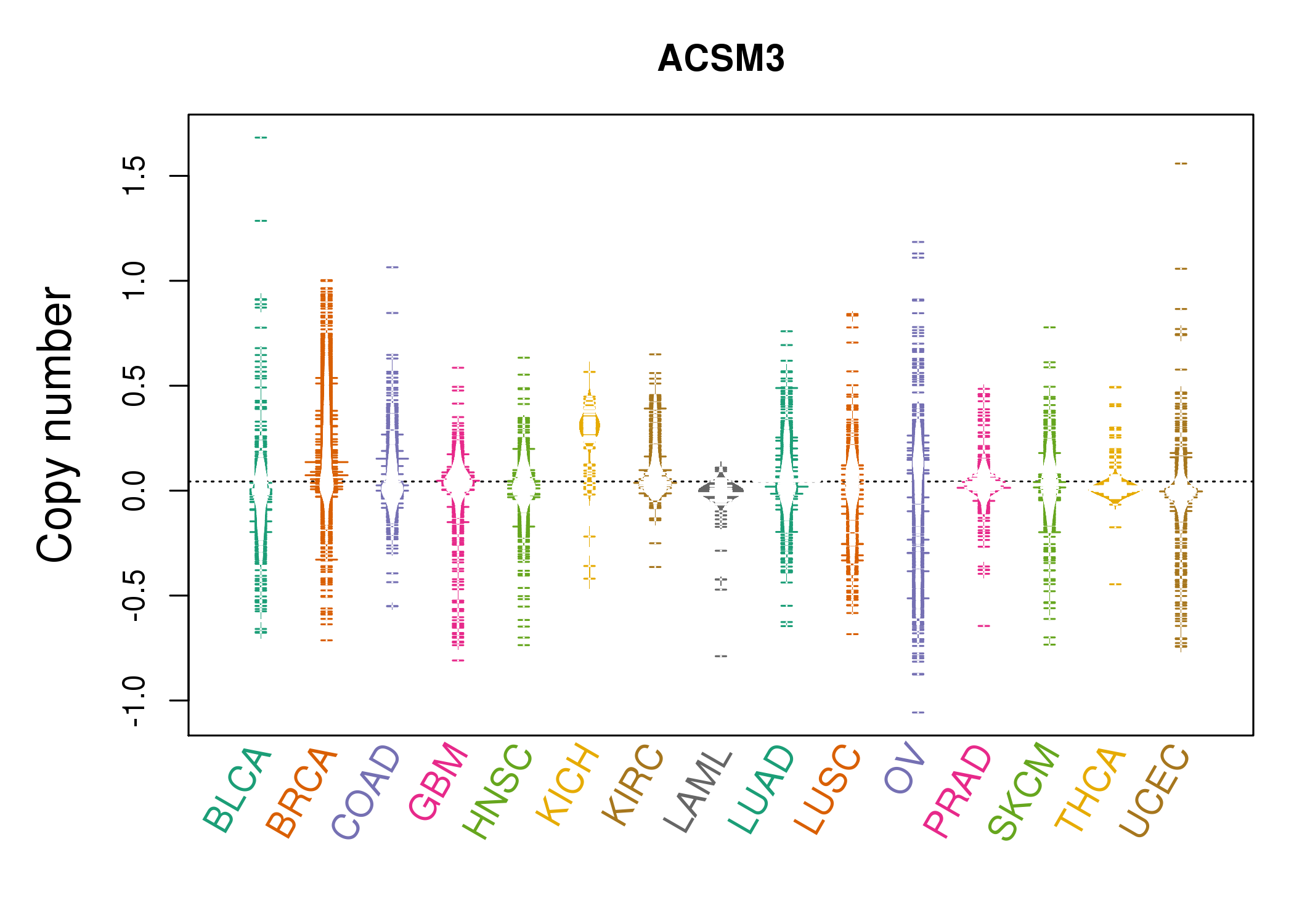 |
| cf) Tissue ID[Tissue type]: BLCA[Bladder Urothelial Carcinoma], BRCA[Breast invasive carcinoma], CESC[Cervical squamous cell carcinoma and endocervical adenocarcinoma], COAD[Colon adenocarcinoma], GBM[Glioblastoma multiforme], Glioma Low Grade, HNSC[Head and Neck squamous cell carcinoma], KICH[Kidney Chromophobe], KIRC[Kidney renal clear cell carcinoma], KIRP[Kidney renal papillary cell carcinoma], LAML[Acute Myeloid Leukemia], LUAD[Lung adenocarcinoma], LUSC[Lung squamous cell carcinoma], OV[Ovarian serous cystadenocarcinoma ], PAAD[Pancreatic adenocarcinoma], PRAD[Prostate adenocarcinoma], SKCM[Skin Cutaneous Melanoma], STAD[Stomach adenocarcinoma], THCA[Thyroid carcinoma], UCEC[Uterine Corpus Endometrial Carcinoma] |
| Top |
| Gene Expression for ACSM3 |
| * CCLE gene expression data were extracted from CCLE_Expression_Entrez_2012-10-18.res: Gene-centric RMA-normalized mRNA expression data. |
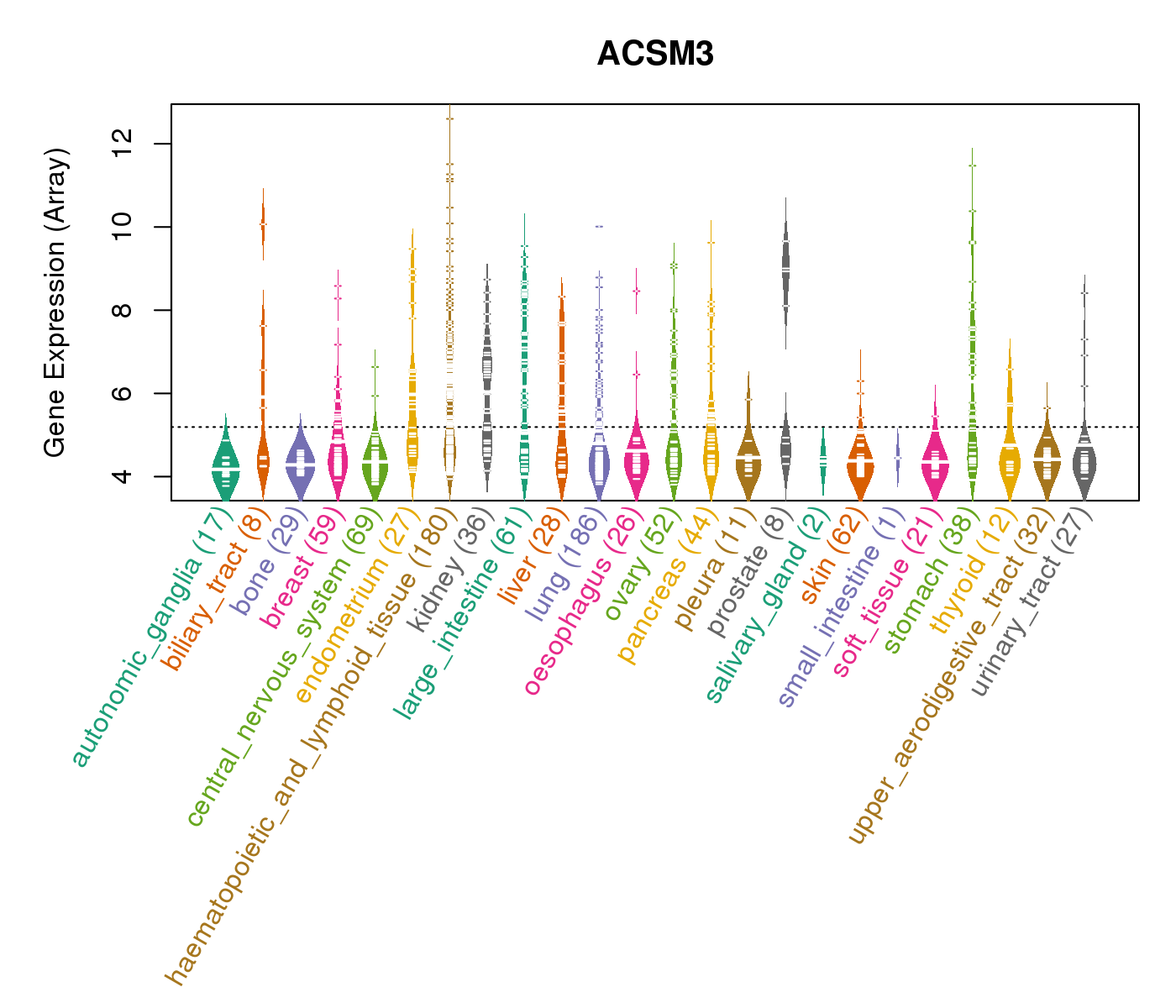 |
| * Normalized gene expression data of RNASeqV2 was extracted from TCGA using R package TCGA-Assembler. The URLs of all public data files on TCGA DCC data server were gathered at Jan-05-2015. Only eight cancer types have enough normal control samples for differential expression analysis. (t test, adjusted p<0.05 (using Benjamini-Hochberg FDR)) |
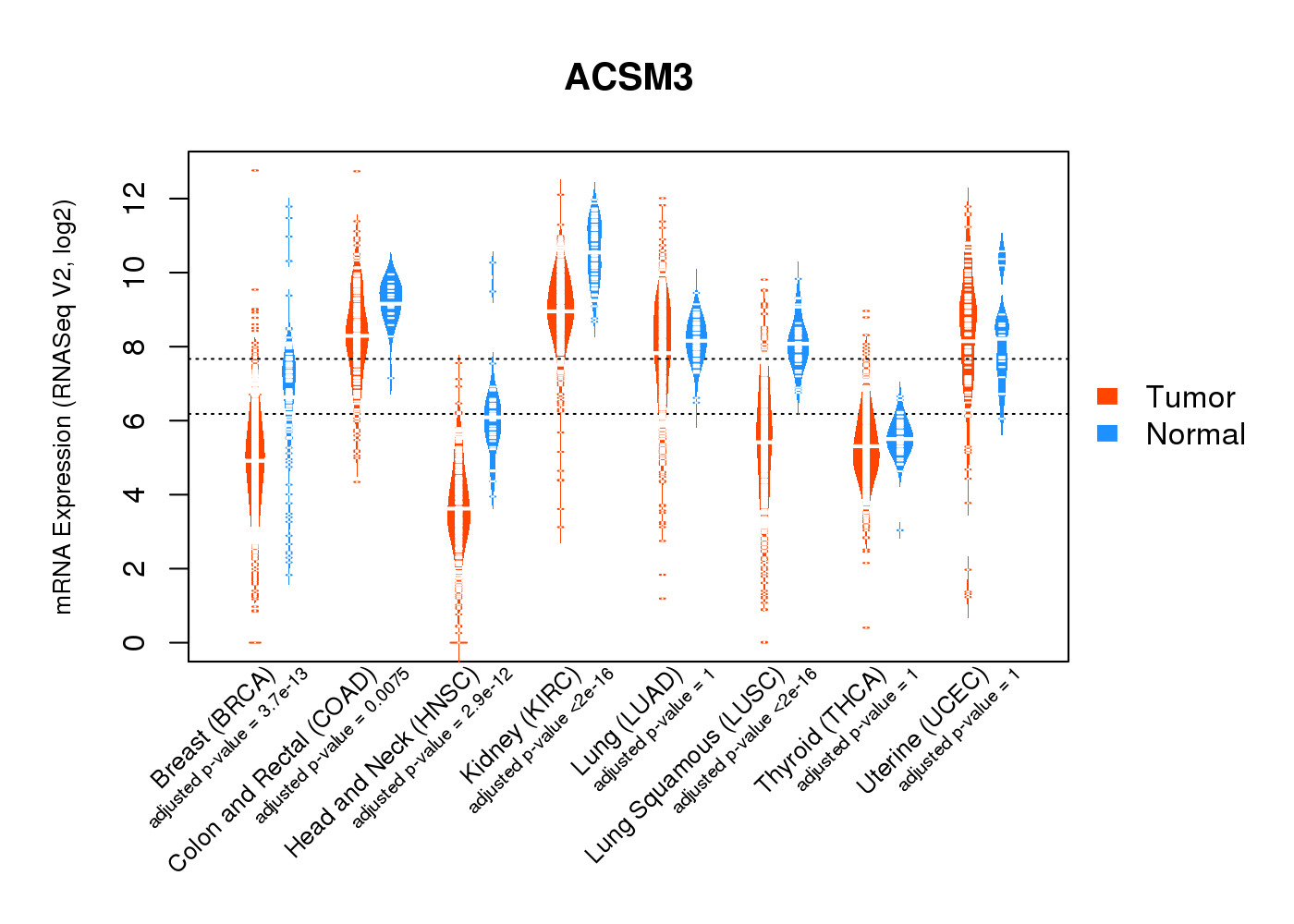 |
| Top |
| * This plots show the correlation between CNV and gene expression. |
: Open all plots for all cancer types
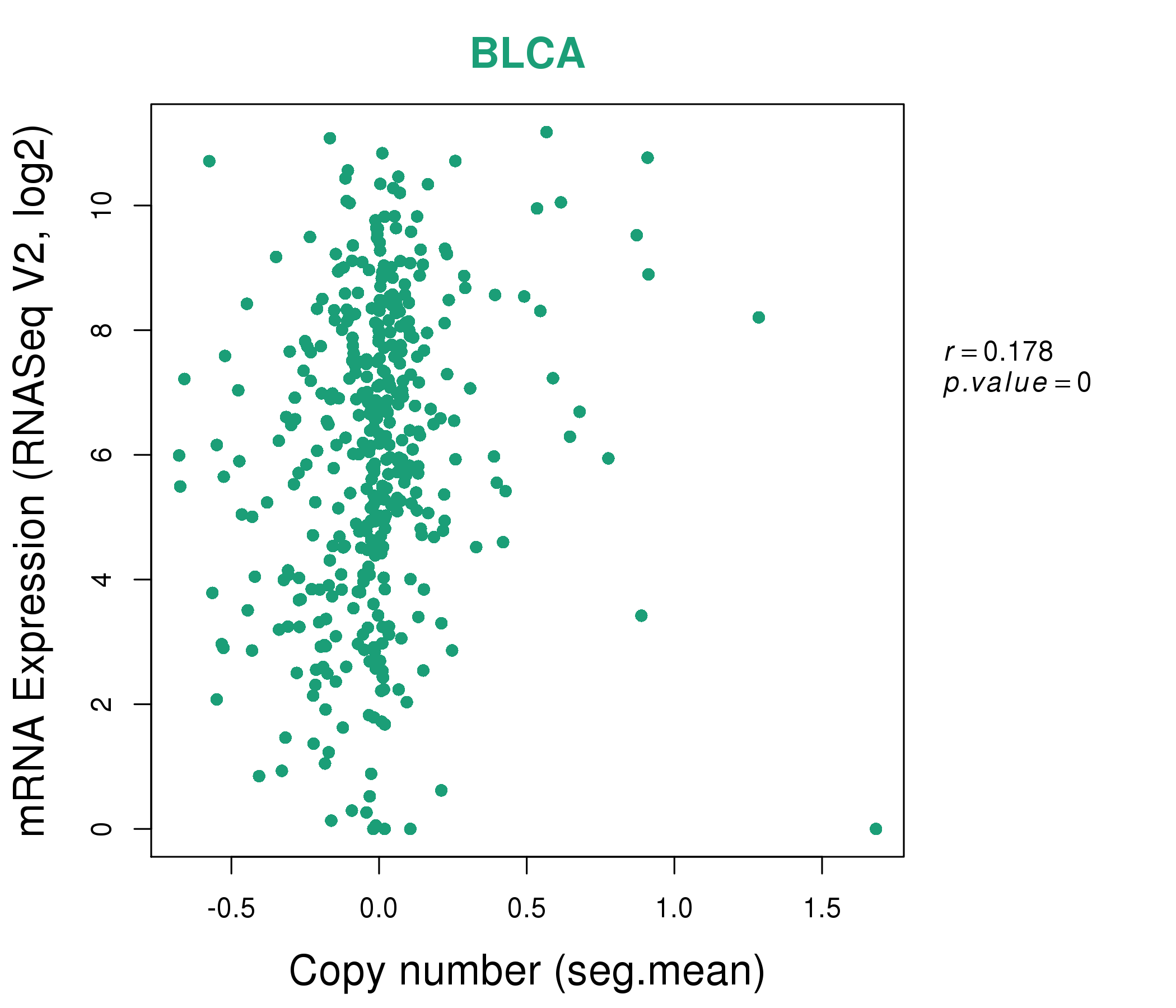 |
|
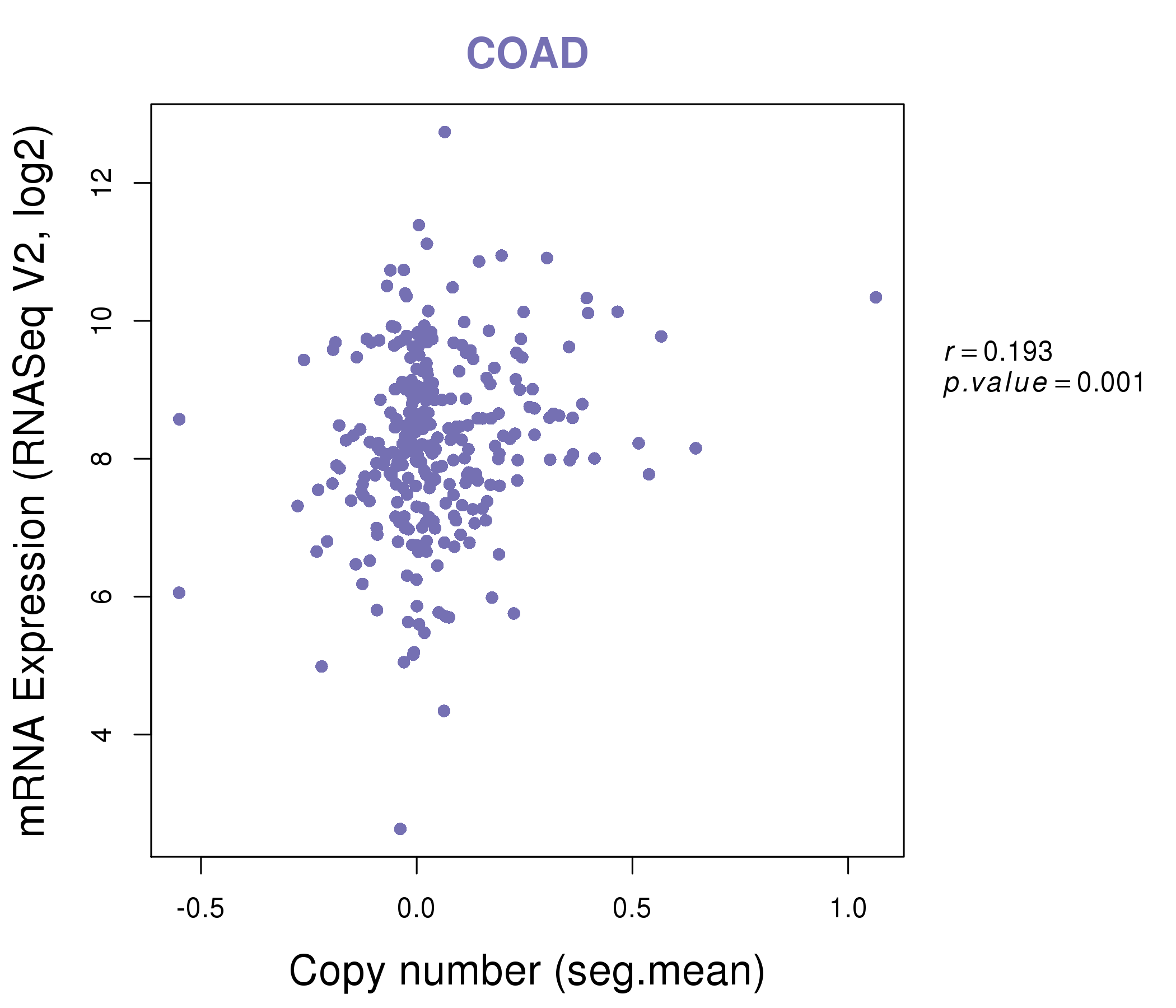 |
|
| Top |
| Gene-Gene Network Information |
| * Co-Expression network figures were drawn using R package igraph. Only the top 20 genes with the highest correlations were shown. Red circle: input gene, orange circle: cell metabolism gene, sky circle: other gene |
: Open all plots for all cancer types
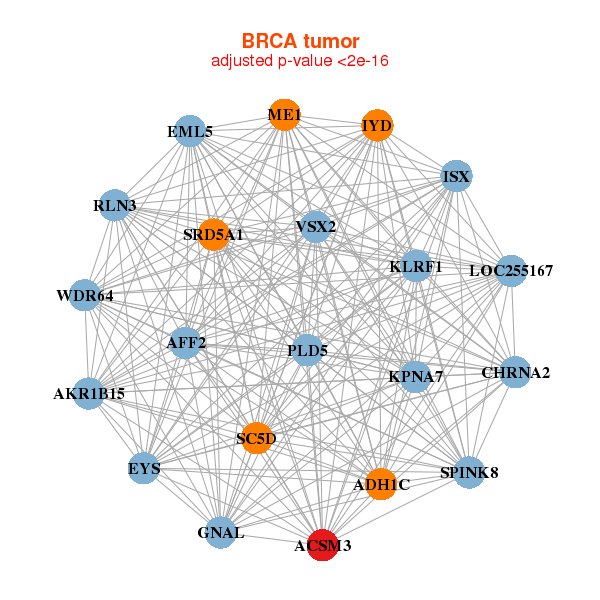 |
|
| ACSM3,ADH1C,AFF2,AKR1B15,CHRNA2,EML5,EYS, GNAL,ISX,IYD,KLRF1,KPNA7,LOC255167,ME1, PLD5,RLN3,SC5D,SPINK8,SRD5A1,VSX2,WDR64 | ABCC11,ABCC2,ACSM3,AFMID,AKR1D1,B3GAT1,C6orf223, CHRNA2,CHST1,CLDN14,GSTT2,HMGCR,INSM2,LOC255167, OR4N4,RIMS1,SLC5A11,SLCO1B1,SYCP1,TRPC7,ZP2 |
 |
|
| ACSM1,ACSM3,CRYM,GNG13,HTR3C,HTR3E,LOC100189589, NPY6R,NXF3,OR2T34,PRH1,PRH2,RGS13,RGS21, SH2D6,SH2D7,TAS1R1,TAS1R2,TCL6,THUMPD1,USP26 | ACSM3,BSPRY,HMGN2P46,CDC25C,CEP70,CNOT10,COX5A, EHF,ERLIN1,FRAT2,MLEC,MTIF2,MYB,RTN4IP1, SCO1,STARD7,STIL,TAF5,TRIM34,WIPI1,ZNF695 |
| * Co-Expression network figures were drawn using R package igraph. Only the top 20 genes with the highest correlations were shown. Red circle: input gene, orange circle: cell metabolism gene, sky circle: other gene |
: Open all plots for all cancer types
| Top |
: Open all interacting genes' information including KEGG pathway for all interacting genes from DAVID
| Top |
| Pharmacological Information for ACSM3 |
| There's no related Drug. |
| Top |
| Cross referenced IDs for ACSM3 |
| * We obtained these cross-references from Uniprot database. It covers 150 different DBs, 18 categories. http://www.uniprot.org/help/cross_references_section |
: Open all cross reference information
|
Copyright © 2016-Present - The Univsersity of Texas Health Science Center at Houston @ |






